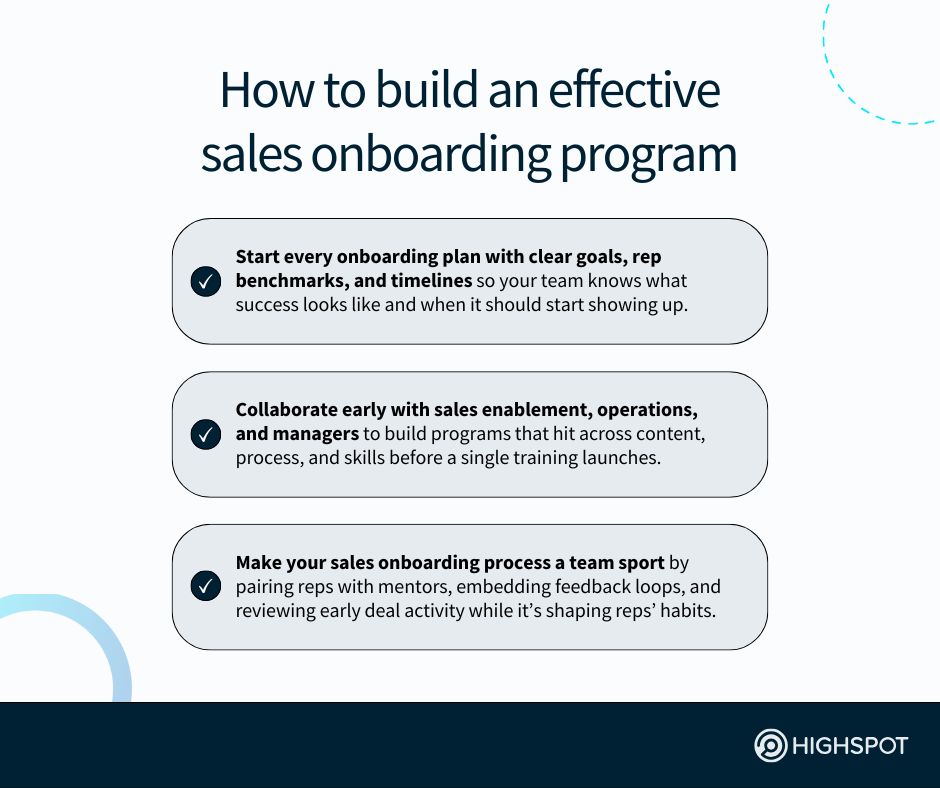Key Takeaways
- An effective sales onboarding programme accelerates ramp time, strengthens rep performance, and creates the consistency needed to drive predictable, revenue-generating behaviours across your team.
- Set up new sales professionals who join your company for success from day one, and equip them with the right training resources and tools to close deals confidently, consistently, and without hesitation.
- By following proven sales onboarding best practices, you’ll increase team-wide execution, reinforce GTM alignment, and build a foundation that supports long-term revenue and retention gains.
Hiring proven sales talent (or at least new hires with the potential to become top performers) is essential. But without an effective sales onboarding process, your new BDRs end up walking into chaos—and that chaos impacts your forecast.
The way you welcome, educate, and ramp sales reps matters more than most teams realise. It shapes rep performance before the first deal is even touched.
Simply put, a poor onboarding experience can sabotage confidence, delay ramp time, and leave your team stuck in “figure-it-out” mode when urgency is high.
The best GTM teams equip, train, guide, and coach these sellers with precision, speed, and consistency. Supporting your sales team with scalable training resources and built-in continuous learning isn’t just smart. It’s survival.
A benefit of world-class onboarding is that it invariably leads to high employee engagement and contributes to a strong company culture. Equally as important, though, it also helps reps build lasting, winning habits that drive real results.
The math here is simple.
As long as you have the right sales onboarding tools, you can keep reps hitting quota, hit your revenue targets, and accelerate growth for your business. But skip a structured onboarding experience—and fail to execute your sales training programmes with best-in-class go-to-market tools—and you’re not just losing time.
The Highspot crew breaks down what the best sales training programmes look like today and how they help both new and experiences reps alike improve daily and better hit their quotas.
What is sales onboarding?
Sales onboarding is the structured process of ramping new reps with the skills, knowledge, tools, and content they need to succeed in their role. It covers product training, messaging, and methodologies and teaches BDRs how to navigate real-world selling situations. Done right, onboarding sets clear expectations, builds confidence early, and shortens the time it takes for sellers to deliver results.
How do leading enterprises build effective sales onboarding strategies today?
Enterprise go-to-market teams align sales onboarding to business outcomes, with clear success metrics tied to pipeline, conversion, and sales quota attainment.
High-performing GTM teams deliver adaptive, role-specific training supported by sales enablement platforms that embed guidance where sellers work. They also combine real-time coaching, AI-powered feedback, and performance insights to drive fast ramp times and consistent execution at scale.
Should there be different types of onboarding sales training for each team member?
Yes, one-size-fits-all training fails because different roles, products, and territories demand custom-tailored content, pacing, and sales coaching support.
The best sales onboarding programmes adapt to each rep’s background, skill level, and responsibilities to make training relevant, targeted, and actionable. Using personalised learning paths and dynamic enablement content ensures every seller builds the right capabilities to succeed in their unique context.
How does new-rep onboarding impact near- and long-term sales performance?
A strong sales onboarding process boosts early confidence for new reps, shortens their ramp time, and helps them accelerate pipeline generation and deal-closing. In the long run, it also builds the ideal habits, messaging fluency, and process discipline that top-performing sellers rely on to stay consistent.
Go-to-market teams with highly structured onboarding hit revenue goals faster and retain more reps, giving them a major edge in competitive markets.
| Common sales onboarding metrics | Example of strong performance |
|---|---|
| Time to first meeting booked | New sales rep booked a first meeting with a qualified prospect within 9 days of completing the onboarding programme |
| Ramp-to-sales-quota timeline | Six out of seven new sales hires hit 100% of quota by the fourth month, versus the historical average of six months |
| Certification completion rate | 96% of new sales hires complete all required training certifications within 21 days of joining the business |
| Time to first closed-won deal | Reps saw first closed-won opportunity within 32 days of ramping, compared to our 45-day baseline for new sellers |
| Pitch score improvement over time | All new reps improved their sales pitch scores by 10 percentage points in month three compared to month one |
The impact of an effective sales onboarding process for your organisation
The near-term impact of a well-oiled sales onboarding machine is evident for new sales professionals: more confidence, less confusion, and better preparedness for when they engage potential customers at each stage of the sales cycle (think objection handling, navigating pricing pressure, reframing competitors).
But other key stakeholders outside the newest members of your sales organisation also benefit from an effective sales onboarding plan that’s well-executed:
- Sales managers ramp reps faster, spend less time correcting basic mistakes, and get more time back to coach on strategic deals.
- Enablement leaders gain clearer visibility into rep readiness and can scale behaviour change with less manual effort or guesswork.
- VPs of Sales see higher early pipeline, faster quota attainment, and more predictable team performance across territories.
- Revenue operations leaders get cleaner data and tighter execution, which improves forecast accuracy and resource planning.
- Product marketers can ensure reps deliver consistent, high-impact messaging that aligns with launches and competitive shifts.
- Enablement coordinators onboard outbound reps with messaging and processes that convert faster and reduce ramp time by weeks.
- Customer success managers inherit better-prepared AEs who set the right expectations and build stronger customer relationships from day one.
The common thread among these individuals in (or adjacent to) your go-to-market organisation? They can use the same, exact tech to carry out, monitor the quality of, and strengthen your sales onboarding programmes—notably, a unified sales enablement tool to gauge the quality of new-hire training.
“On-demand, AI-supported onboarding and coaching empowers sellers to learn and repeat successful selling behaviours,” Highspot’s How to Streamline your Sales Process to Achieve Predictable Growth Guide explains. And that’s exactly what our sales enablement platform offers GTM teams like yours.
With Highspot, sales managers ramp reps faster with less guesswork; enablement teams deliver scalable, high-impact onboarding programmes, and RevOps leaders easily connect training activity to revenue outcomes. A win-win-win.
As the sales enablement leader at Flight Centre Travel Group explains, FCTG has accelerated new-rep ramp time and transformed its sales onboarding process at large using Highspot.
Building your sales onboarding programme: A 5-step process for GTM leaders
As with any business process, there’s no one ‘right’ way to go about establishing a new onboarding programme or refining an existing one. That said, there are five core steps that the best sales managers and GTM leaders follow to develop a training programme that levels up their new reps’ skills from the get-go.
1. Create a seamless onboarding experience in partnership with sales enablement
To run a better sales onboarding process, start by teaming up with sales enablement early. Align on content, timelines, and workflows before day one to reduce confusion and boost engagement. Make space for both foundational knowledge and in-role ramping so the learning sticks long past week one.
When the handoff between sales enablement teams and managers is smooth, the entire sales organisation benefits from faster, more confident execution.
2. Define clear ramp goals, timelines, and expected outcomes for your new sales reps
Set lofty but realistic targets for all new hires that go beyond time-to-quota and first closed-won. Lay out a timeline for pipeline creation, activity benchmarks, and key selling milestones. Use this framework to hold yourself and other managers accountable and support each rep’s confidence and consistency.
With strong, clear expectations in place for new reps, your sales onboarding programme becomes the launchpad for sustainable, long-term performance.
3. Align onboarding content, like training assessments, with your sales methodology
Whether you use SPIN selling, Challenger sales, the MEDDIC framework, or another sales methodology altogether, be sure to bake it into sales onboarding early.
Use custom training lessons, AI sales role play, and live call reviews to reinforce key motions and language. Also, create sales onboarding certification checkpoints to make sure reps can apply the methodology in live deal scenarios.
A consistent, measurable approach is what helps you ensure your sales team speaks the same language and sells with conviction from the first call forward.
4. Track onboarding impact with rep scorecards that can guide sales leaders’ decisions
Consider how go-to-market leaders with Highspot use our sales scorecards as their single source for rep ramp data and subsequent performance with selling. They can easily tie BDR behaviour, like training completion, pitching, and meeting activity, to pipeline progression and revenue conversion.
Let the numbers guide you toward stronger sales coaching, clearer expectations, and faster course correction. With onboarding data that flows into your sales strategy, you can adjust your sales processes before small issues stall progress.
5. Ensure new hires can hit the ground running with all tools in your sales tech stack
Give your sales reps a day-one walkthrough of the GTM tools they’ll use: from your customer relationship management system, to your enablement platform.
Build exercises into sales onboarding that require reps to complete real tasks in the actual tools. Make sure permissions are sorted and logins are working before that welcome coffee gets cold. Tech fluency helps BDRs sell smarter and faster—and, big picture, helps them continually improve sales performance.

Sales enablement best practices: Tips for training new salespeople
Today, a highly effective sales onboarding process for go-to-market teams “goes beyond passive absorption of knowledge or rote memorisation,” Highspot’s Sales Onboarding Guide: How to Shorten Sales Ramp to Revenue explained.
“By actively experiencing a concept or behaviour, your reps will begin to develop their sales ‘muscle memory’ that can help them succeed on your team,” per the guide.
“Common active learning strategies include role-playing, teach-back moments, breakout discussion groups, and small projects that include peer review.”
Of course, active learning is just one of many key elements required to deliver a high-quality sales training programme for all new hires who join your organisation. There are also other sales onboarding best practices you must follow.
Invest in AI-powered sales onboarding tools to accelerate real-world readiness
Great onboarding should feel less like a handbook and more like a high-stakes simulation. With the right tools, new sales team members can rehearse, respond, and react under pressure (and before they risk blowing a live deal).
For example, the conversation intelligence tied to recent sales calls in Highspot can help your reps and managers alike uncover patterns, assess buyer behaviours, surface coaching moments, and fine-tune responses with precision.
Used right, AI sales tools like Highspot become assistant coaches that help each seller internalise your messaging faster, without piling extra work on managers.
Give your sales reps real talk, not role-play theatre, when it comes to practice
If your sales scripts sound like they were written for community theatre, your reps are in trouble.
Practice should feel like a messy first call, not a polished TED Talk. Drop your sellers into AI sales role play exercises and mock live sessions where buyers push back, change their minds, or ghost entirely.
The more practice feels like the real thing, the more your sales reps will be prepared for when things inevitably go wrong or sideways in deal discussions.
Turn your entire sales team into experts, not tourists, in your B2B buyers’ world
New sales reps can’t just skim your particular industry. They need to live in it, breathe it, understand every nuance your prospects care about. If they don’t learn the pain behind the problem during sales onboarding programmes, then they end up pitching features to buyers who are already 10 steps ahead.
Build helpful training materials that frame value from the prospect’s side of the table, not just your own.
When your sales representatives start thinking like potential customers, that’s when deals start moving and your leads start converting.
Build sales skills with real examples, not hypothetical ‘happy-path’ scenarios
That ‘dream call’ where the buyer agrees, nods, and says, “Send the contract” in 12 minutes!” is fantasy fiction. Use actual sales calls—wins, losses, and no-decisions—to show what strong execution looks like under pressure.
Pull conversation clips that reveal hesitation, objections, and how experienced reps navigate them. Better yet, have an AI sales agent do it for you to get an automated, detailed summary of what distinguishes ‘good’ calls from ‘bad’ ones so reps can see what approach and messaging resonates with buyers.
Get new sales hires fluent in the art of pitching before touching an opportunity
Before any of your new hires touches a CRM field, they should be able to pitch it cold, sell it live, and recover well when challenged. Build your sales onboarding process around small, repeatable pitch checkpoints that evolve over time.
Use sales methodology training to ensure messaging doesn’t melt under pressure and that every pitch tells a story buyers want to hear. No one wants a rep on their call learning live, especially your high-intent prospects who expected a pro.
Create a sales culture of continuous learning, not one-and-done certifications
Certifications are a starting line, not a summit. Real progress shows up when reps stay hungry past week four. An effective sales onboarding programme focuses on re-engagement: nudges, reminders, and refreshers baked into daily flows.
Pair up your sales reps for post-call breakdowns, quick-hit debriefs, and feedback loops that spark fast skill gains. When you and other managers normalise continuous feedback, momentum follows (along with the wins and revenue).
Remember: Structured onboarding isn’t just a checklist, but rather a GTM ritual
A poor onboarding experience is more than a miss. It’s a momentum-killer that lingers deep into the quarter. So, your sales onboarding process should reflect the seriousness of what’s at stake: pipeline, people, performance.
Ritualise early wins, weekly milestones, and learning moments to shape how all sales reps show up.
When onboarding is done right, it prepares reps to sell smart and signals what your sales culture expects and rewards.
Ongoing coaching and training: A post-onboarding checklist for sales managers
“Many companies have sophisticated training teams and schedules that help their onboarding run smoothly,” according to Highspot’s What Good Sales Onboarding, Training, and Coaching Looks Like Guide for go-to-market teams. “But this approach to onboarding lacks a critical element: enduring learning.”
Translation? Sales onboarding success is great—but it’s just ‘phase one.’ To ensure BDRs continue to improve over time, you and other GTM leaders must:
- Revisit what they learnt during the sales onboarding process to reinforce foundational knowledge, close lingering gaps, and build lasting confidence.
- Meet regularly with your sales reps for 1:1 coaching sessions to discuss recent pipeline blockers, messaging misfires with buyer engagement, and skill refinement.
- Create AI-driven adaptive learning paths for each new seller using an enablement platform that factors in ramp stage, performance data, and role expectations.
- Leverage data from each sales onboarding programme and class to pinpoint what drives ‘success’ (getting caught up quickly) and focus on continuous improvement.
- Track ‘lagging’ key performance indicators like sales quota attainment, pipeline generation, and content utilisation to spot coaching opportunities early on.
- Use an AI sales role play tool such as Highspot to simulate objections and provide consistent, real-time feedback without having to spend a ton of time with each rep.
- Help sellers prepare for calls in their first few months on the job with conversation intelligence from BDRs’ sales calls, real buyer questions, and past deal reviews.
- Keep your sales playbook and related plays current with robust training materials and ongoing guidance that aligns with your go-to-market strategy.
The most effective onboarding programmes don’t stay great on autopilot. They demand iteration, insight, and bold thinking from every GTM leader involved.
The stronger your sales onboarding process, the more likely your team is to hit revenue goals, retain top performers, and outperform expectations.
Keep levelling it up. Every improvement made upstream sends ripple effects into sales pipeline, performance, and the talent that sticks around to help your go-to-market organisation continue to raise the bar and reach new heights.




